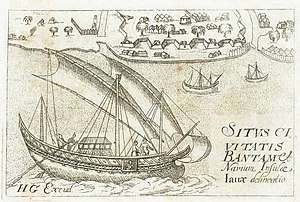Javanese people
The Javanese people (Javanese: Ngoko: ꦮꦺꦴꦁꦗꦮ (Wong Jawa), Krama: ꦠꦶꦪꦁꦗꦮꦶ (Tiyang Jawi);[18] (Indonesian: Suku Jawa or Orang Jawa) are an ethnic group native to the Indonesian island of Java. With approximately 100 million people,[19] they form the largest ethnic group in Indonesia. They are predominantly located in the central to eastern parts of the island. There are also significant numbers of people of Javanese descent in most provinces of Indonesia, Malaysia, Singapore, Suriname, Saudi Arabia and the Netherlands.
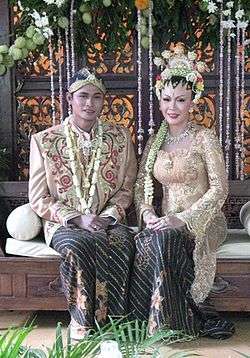 A Javanese bride and groom wearing their traditional garb | |
| Total population | |
|---|---|
| c. 95–100 million | |
| Regions with significant populations | |
| 95,217,022[2] | |
| 1,500,000+[3] | |
| 1,500,000 (2014)[4][5] | |
| 190,000–240,000 (2018)[6][7] | |
| 151,021 (2016)[8] | |
| 150,000 (2018)[9] | |
| 114,000 (2014)[10] | |
| 81,915 (2019)[11] | |
| 48,000 (2014)[10] | |
| 40,148 (2014) | |
| 33,000 (2014)[10] | |
| 28,000 (2014)[10] | |
| 21,700 (Javanese Surinamese)[12][13] | |
| 7,000–16,000 (2016)[14] | |
| 12,000[15] | |
| 4,100[16] | |
| 2,400[17] | |
| Languages | |
| Javanese Malay (predominantly Indonesian or Malaysian) | |
| Religion | |
| Predominantly Sunni Islam Protestant, Roman Catholic, Shaivite Hindu, Vajrayana Buddhist, Kejawèn minorities | |
| Related ethnic groups | |
| Other Austronesian peoples | |
The Javanese ethnic group has many sub-groups, such as the Mataram, Cirebonese, Osing, Tenggerese, Samin, Naganese, Banyumasan, etc.[20]
A majority of the Javanese people identify themselves as Muslims, with a minority identifying as Christians and Hindus. However, Javanese civilization has been influenced by more than a millennium of interactions between the native animism Kejawen and the Indian Hindu—Buddhist culture, and this influence is still visible in Javanese history, culture, traditions, and art forms. With a sizeable global population, the Javanese are considered significant as they are the fourth largest ethnic group among Muslims in the world after the Arabs,[21] Bengalis[22] and Punjabis.[23]
History
Like most Indonesian ethnic groups, including the Sundanese of West Java, the Javanese are of Austronesian origins whose ancestors are thought to have originated in Taiwan, and migrated through the Philippines[24] to reach Java between 1,500BC and 1,000BC.[25] However, according to recent genetic study, Javanese together with Sundanese and Balinese has almost equal ratio of genetic marker shared between Austronesian and Austroasiatic heritages.[26]
Ancient Javanese kingdoms and empires
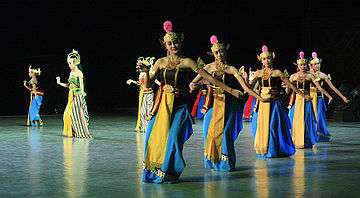
Hindu and Buddhist influences arrived through trade contacts with the Indian subcontinent.[27] Hindu and Buddhist - traders and visitors, arrived in the 5th century. The Hindu, Buddhist and Javanese faiths blended into a unique local philosophy.[24]
The cradle of Javanese culture is commonly described as being in Kedu and Kewu Plain in the fertile slopes of Mount Merapi as the heart of the Medang i Bhumi Mataram kingdom.[28] The earliest Sanjaya and Sailendra dynasties had their power base there.[29]:238–239
The centre of Javanese culture and politics was moved towards the eastern part of the island when Mpu Sindok (r. 929-947) moved the capital of the kingdoms eastward to the valleys of the Brantas River in the 10th century CE. The move was most likely caused by the volcanic eruption of Merapi and/or invasion from Srivijaya.[29]:238–239
The major spread of Javanese influence occurred under King Kertanegara of Singhasari in the late 13th century. The expansionist king launched several major expeditions to Madura, Bali in 1284,[30] Borneo and most importantly to Sumatra in 1275.[29] Following the defeat of the Melayu Kingdom, Singhasari controlled trade in the Strait of Malacca.
Singhasari dominance was cut short in 1292 by Kediri's rebellion under Jayakatwang, killing Kertanegara. However, Jayakatwang's reign as king of Java soon ended as he was defeated by Kertanegara's son-in-law, Raden Wijaya with the help of invading Mongol troops in March 1293.
Raden Wijaya would later establish Majapahit near the delta of the Brantas River in modern-day Mojokerto, East Java. Kertanegara policies were later continued by the Majapahits under King Hayam Wuruk and his minister Gajah Mada.[30]
Various kingdoms of Java were actively involved in the spice trade in the sea route of the Silk Road. Although not major spice producers, these kingdoms were able to stockpile spice by trading for it with rice, of which Java was a major producer.[31] Majapahit is usually regarded as the greatest of these kingdoms. It was both an agrarian and a maritime power, combining wet-rice cultivation and foreign trade.[32] The ruin of their capital can be found in Trowulan.
Javanese sultanates
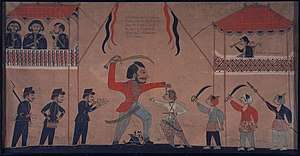
Islam gained its foothold in port towns on Java's northern coast such as Gresik, Ampel Denta (Surabaya), Tuban, Demak and Kudus. The spread and proselytising of Islam among the Javanese was traditionally credited to Wali Songo.[33]
Java underwent major changes as Islam spread. Following succession disputes and civil wars, Majapahit power collapsed. After this collapse, its various dependencies and vassals broke free.[34] The Sultanate of Demak became the new strongest power, gaining supremacy among city-states on the northern coast of Java.[35] Aside from its power over Javanese city-states, it also gained overlordship of the ports of Jambi and Palembang in eastern Sumatra.[35] Demak played a major role in opposing the newly arrived colonial power, the Portuguese. Demak twice attacked the Portuguese following their capture of Malacca. They also attacked the allied forces of the Portuguese and the Sunda Kingdom, establishing in the process the Sultanate of Banten.
Demak was succeeded by the Kingdom of Pajang and finally the Sultanate of Mataram. The centre of power moved from coastal Demak, to Pajang in Blora, and later further inland to Mataram lands in Kotagede, near present-day Yogyakarta. The Mataram Sultanate reached its peak of power and influence during the reign of Sultan Agung Hanyokrokusumo between 1613 and 1645.
Colonial Java
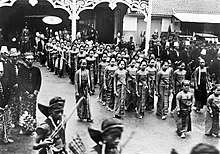
In 1619 the Dutch established their trading headquarter in Batavia. Java slowly fell to the Dutch East India Company, which would also eventually control most of Maritime Southeast Asia. The internal intrigue and war of succession, in addition to Dutch interference, caused the Mataram Sultanate to break up into Surakarta and Yogyakarta. The further separation of the Javanese realm was marked by the establishment of the Mangkunegaran and Pakualaman princedom. Although the real political power in those days actually lay with the colonial Dutch, the Javanese kings, in their keratons, still held prestige as the supposed power centre of the Javanese realm, especially in and around Surakarta and Yogyakarta.
Dutch rule was briefly interrupted by British rule in the early 19th century. While short, the British administration led by Stamford Raffles was significant, and included the re-discovery of Borobudur. Conflict with foreign rule was exemplified by the Java War between 1825 and 1830, and the leadership of Prince Diponegoro.
Like the rest of the Dutch East Indies, Java was captured by the Empire of Japan during World War II. With Japan's defeat, independence was proclaimed in the new Republic of Indonesia.
Republic of Indonesia
When the Indonesian independence was proclaimed on 17 August 1945, the last sovereign Javanese monarchies, represented by the Sri Sultan of Yogyakarta, the Sunanate of Surakarta and Prince of Mangkunegara declared that they would become part of the Republic of Indonesia.
Yogyakarta and Pakualam were later united to form the Yogyakarta Special Region. The Sri sultan became Governor of Yogyakarta, and the Prince of Pakualaman became vice-governor; both were responsible to the President of Indonesia. The Special Region of Yogyakarta was created after the war of independence ended and formalised on 3 August 1950. Surakarta was later absorbed as part of the Central Java province.
Culture
The Javanese culture is one of the oldest civilisations and has flourished in Indonesia. It has gradually absorbed various elements and influences from other cultures, including native reverence for ancestral and natural spirits, Hindu and Buddhist dharmic civilisation, Islamic values, and to a lesser extent, Christianity, Western philosophy and modern ideas. Nevertheless, Javanese culture — especially in the Javanese cultural heartland; those of highly polished aristocratic culture of the keratons in Yogyakarta and Surakarta — demonstrates some specific traits, such as particular concern with elegance and refinement (Javanese: alus), subtlety, politeness, courtesy, indirectness, emotional restraint and consciousness to one's social stature. Javanese culture values harmony and social order highly, and abhors direct conflicts and disagreements. These Javanese values are often promoted through Javanese cultural expressions, such as Javanese dance, gamelan, wayang and batik. It is also reinforced through adherence to Javanese adat (traditional rules) in ceremonies, such as Slametan, Satu Suro, Javanese weddings and Naloni Mitoni.
However, the culture of pesisiran of Javanese north coast and in Eastern Java demonstrates some slightly different traits. They tend to be more open to new and foreign ideas, more egalitarian, and less conscious of one's social stature. Some of these northern settlements — such as Demak, Kudus, Tuban, Gresik and Ampel in Surabaya — have become more overtly Islamic, traditionally because these port towns are among the earliest places that Islamic teachings gained foothold in Java.
Javanese culture is traditionally centred in the Central Java, Yogyakarta and East Java provinces of Indonesia. Due to various migrations, it can also be found in other parts of the world, such as Suriname (where 15% of the population are of Javanese descent), the broader Indonesian archipelago region,[36] Cape Malay,[37] Malaysia, Singapore, Netherlands and other countries. The migrants bring with them various aspect of Javanese cultures such as Gamelan music, traditional dances[38] and the art of Wayang kulit shadow play.[39] The migration of Javanese people westward has created a coastal Javanese culture in West Java distinct from the inland Sundanese culture.
Language

Javanese is a member of the Austronesian family of languages and is closely related to, but distinct from, other languages of Indonesia.[40] It is notable for its great number of nearly ubiquitous Sanskrit loans, found especially in literary Javanese.[41] This is due to the long history of Hindu and Buddhist influences in Java.
Many Javanese in Indonesia are bilingual, being fluent in Indonesian (the standardized variant of the Malay language) and Javanese.[42] In a public poll held circa-1990, approximately 12% of Javanese used Indonesian, around 18% used both Javanese and Indonesian, and the rest used Javanese exclusively.
The Javanese language was formerly written with a script descended from the Brahmi script, natively known as Hanacaraka or Carakan. Upon Indonesian independence it was replaced with a form of the Latin alphabet. While Javanese was not made an official language of Indonesia, it has the status of regional language for communication in the Javanese-majority regions. The language also can be viewed as an ethnic language because it is one of the defining characteristics of the Javanese ethnic identity.[40]
Literature and philosophy
Javanese intellectuals, writers, poets and men of letters are known for their ability to formulate ideas and creating idioms for high cultural purpose, through stringing words to express a deeper philosophical meanings. Several philosophical idioms sprung from Javanese classical literature, Javanese historical texts and oral traditions, and have spread into several media and promoted as popular mottos. For example, "Bhinneka Tunggal Ika", used as the national motto of the Republic of Indonesia, "Gemah Ripah Loh Jinawi, Toto Tentrem Kerto Raharjo", "Jer Basuki Mawa Bea", "Rawe-Rawe rantas, Malang-Malang putung" and "Tut Wuri Handayani".[43]
Social structure
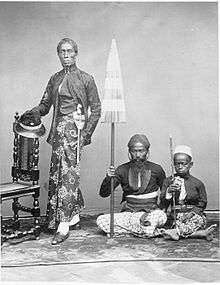
American anthropologist Clifford Geertz divided in the 1960s the Javanese community into three aliran or "streams": santri, abangan and priyayi. According to him, the Santri followed an orthodox interpretation Islam, the abangan followed a syncretic form of Islam that mixed Hindu and animist elements (often termed Kejawen), and the priyayi were the nobility.[44]
The Geertz opinion is often opposed today because he mixed the social groups with belief groups. It was also difficult to apply this social categorisation in classing outsiders, for example other non-indigenous Indonesians such as persons of Arab, Chinese and Indian descent.
Social stratification is much less rigid in northern coast area.
Religion
Today, most Javanese officially follow Islam as their religion,[46] Orthodox Muslims are most common in the northern coast bordering the Java Sea, where Islam was first brought to the island. Islam first came in contact with Java during the Majapahit period, when they traded or made tributary relations with various states like Perlak and Samudra Pasai in modern-day Aceh.[32]
A minority of Javanese also follow Christianity (Protestantism and Catholicism), which are concentrated in Central Java (particularly Surakarta, Magelang and Yogyakarta for Catholicism). Native Christian churches such as the Gereja Kristen Jawa also exist. On a smaller scale, Buddhism and Hinduism are also found in the Javanese community. The Javanese of the Tengger tribe continue to practice Javanese-Hindu today, and live in villages on the slope of Mount Bromo.[47]
Kebatinan, also called Kejawen,[48] Agama Jawa[49] and Kepercayaan[50] is a Javanese religious tradition, consisting of an amalgam of animistic, Hindu-Buddhist, and Islamic, especially Sufi, beliefs and practices. It is rooted in Javanese history and religiosity, syncretising aspects of different religions.
Calendar
The Javanese calendar is used by the Javanese people concurrently with two other calendars, the Gregorian calendar and the Islamic calendar. The Gregorian calendar is the official calendar of Indonesia, while the Islamic calendar is used by Muslims and Indonesian government for religious worship and deciding relevant Islamic holidays. The Javanese calendar is presently used mostly for cultural events (such as Siji Surå). The Javanese calendar system is currently a lunar calendar adopted by Sultan Agung in 1633, based on the Islamic calendar. Previously, Javanese people used a solar system based on the Hindu calendar.
Unlike many other calendars, the Javanese calendar uses a 5-day week known as the Pasaran cycle. This is still in use today and is superimposed with 7-day week of the Gregorian calendar and Islamic calendar to become what is known as the 35-day Wetonan cycle.
Architecture
.jpg)
Throughout their long history, the Javanese have produced many important buildings, ranging from Hindu monuments, Buddhist stupa, mortuary temples, palace complexes, and mosques.
Two important religious monuments are the Hindu temple of Prambanan and the Buddhist temple of Borobudur. Both of them are 9th century temples and UNESCO World Heritage Sites. Both are located near Yogyakarta in the slope of Mount Merapi.
Meanwhile, examples of secular buildings can be seen in the ruins of the former capital city of the Majapahit Kingdom (14th to 16th century AD) in Trowulan, East Java. The complex covers an area of 11 km x 9 km. It consists of various brick buildings, a canal ranging from 20 to 40 meters wide, purification pools, temples and iconic split gates.[51] The capital complex is currently being considered as a candidate for becoming a UNESCO World Heritage Site.
Traditional Javanese buildings can be identified by their trapezoid shaped roofs supported by wooden pillars.[52] Another common feature in Javanese buildings are pendopo, pavilions with open-sides and four large pillars. The pillars and other parts of the buildings can be richly carved. This architecture style can be found at kraton, or palaces, of the Sultanates of Yogyakarta (palaces of Hamengkubuwono and Pakualaman) and Surakarta (palaces of Pakubuwono and Mangkunegaran).[53]
Traditional mosques in Java maintain a distinctive Javanese style. The pendopo model is used as the main feature of mosques as prayer halls. A trapezoidal roof is used instead of the more typically Muslim dome. These roofs are often multi-tiered and tiled.[54] In addition to not using domes, traditional Javanese mosques also often lack minarets.[55] The split gate from earlier Hindu-Buddhist period is still used in many mosques and public buildings in Java.
Some notable examples of mosques using traditional Javanese architecture include the Agung Demak Mosque, the Menara Kudus Mosque and the Grand Mosque of Banten. The Kudus Mosque is also of note because it incorporates Hindu-style stone architecture.
Cuisine
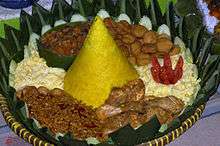
Javanese cuisine and culture place an important role in rice, which is a staple food on the island. Among the Javanese it is considered not to be a meal if a person hasn't eaten rice yet.[56] It is also important part of identity that differentiate Javanese with foreigners that eat bread (the Europeans) and resident of other island who eat sago (for example Moluccans). Rice is also symbol of development and prosperity, while cassava and tuber is associated with poverty.[57]
Javanese cuisine varies by region. Eastern Javanese cuisine has a preference for more salty and hot foods,[57] while the Central Javanese prefer sweeter foods.
A famous food in Javanese cuisine is Rujak Cingur,[58] marinated cow lips and noses served with vegetable, shrimp prawn and peanut sauce with chili. Rojak Cingur is considered a traditional food in Surabaya in East Java.
Gudeg is a traditional food from Yogyakarta[59] and Central Java which is made from young Nangka (jack fruit) boiled for several hours with palm sugar, and coconut milk.
Pecel, a type of peanut sauce with chili[60] is a common ingredient in Javanese cuisine. It is used in various types of Rujak and Gado-gado. It can also be used as stand-alone sauce with rice, prawns, eggs and vegetables as Nasi Pecel (Pecel rice).[61]
Tumpeng, is a rice served in the shape of a conical volcano,[62] usually with rice coloured yellow using turmeric. It is an important part of many ceremonies in Java. Tumpeng is served at landmark events such as birthdays, moving house, or other ceremonies.[63] Traditionally, Tumpeng is served alongside fried chicken, boiled egg, vegetables, and goat meat on a round plate made from bamboo called besek.
A notable food in Java is tempeh, a meat substitute made from soybean fermented with mould. It is a staple source of protein in Java and popular around the world as a meat substitute for vegetarians.
Names
Javanese do not usually have family names or surnames, with only a single name. Javanese names may come from traditional Javanese languages, many of which are derived from Sanskrit. Names with the prefix Su-, which means good, are very popular. After the advent of Islam, many Javanese began to use Arabic names, especially coast populations, where Islamic influences are stronger. Commoners usually only have one-word names, while nobilities use two-or-more-word names, but rarely a surname. Some people use a patronymic. Due to the influence of other cultures, many people started using names from other languages, mainly European languages. Christian Javanese usually use Latin baptism names followed by a traditional Javanese name.
Occupations
In Indonesia, Javanese people can be found in all occupations, especially in the government and the military.
Farming
Traditionally, most Javanese people are farmers. Farming is especially common because of the fertile volcanic soil in Java. The most important agricultural commodity is rice. In 1997, it was estimated that Java produced 55% of Indonesia's total output of the crop.[64] Most farmers work in small-scale rice fields, with around 42% of farmers working and cultivating less than 0.5 hectares of land.[64] In region where soil is less fertile of where rainy season is short, other staple crops is cultivated, such as cassava.[65]
Merchant-Sailor
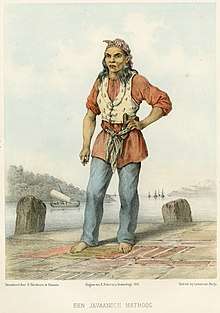
In ancient times, the Javanese people excelled at navigating the seas and trading. This is because not all commodities can be found at the island of Java, and trading is required to fulfill the life necessities. Javanese merchants and sailors were already in frequent voyage in the seas between India and China as early as 1st century CE.[66] The Borobudur ship of the Javanese Sailendra dynasty brought Nusantaran sailors and settlers to Ghana and Madagascar in the 8th century CE,[67] but there is a possibility that they were there as early as 500 BCE.[68][69]
During the Majapahit era, almost all of the commodities from Asia were found in Java. This is because of extensive shipping by the Majapahit empire using various type of ships, particularly the jong, for trading to faraway places.[70]:267–293 Ma Huan (Zheng He's translator) who visited Java in 1413, stated that ports in Java were trading goods and offer services that were more numerous and more complete than other ports in Southeast Asia.[70]:241 It was also during Majapahit era that Nusantaran exploration reached its greatest accomplishment. Ludovico di Varthema (1470-1517), in his book Itinerario de Ludouico de Varthema Bolognese stated that the Southern Javanese people sailed to "far Southern lands" up to the point they arrived at an island where a day only lasted four hours long and was "colder than in any part of the world". Modern studies have determined that such place is located at least 900 nautical miles (1666 km) south of the southernmost point of Tasmania.[71] When Afonso de Albuquerque conquered Malacca, the Portuguese recovered a chart from a Javanese pilot, which already included part of the Americas.[72]
The Javanese people, like other Austronesian ethnicities, use a solid navigation system: Orientation at sea is carried out using a variety of different natural signs, and by using a very distinctive astronomy technique called "star path navigation". Basically, the navigators determine the bow of the ship to the islands that are recognized by using the position of rising and setting of certain stars above the horizon.[73]:10 In the Majapahit era, compasses and magnets were used, and cartography (mapping science) was developed: The use of maps full of longitudinal and transverse lines, rhumb lines, and direct route lines traveled by ships were recorded by Europeans, to the point that the Portuguese considered the Javanese maps were the best map in the early 1500s.[71][74]
European colonial presence diminished the range of the Javanese merchant-sailors. However, in 1602, Diogo de Couto confirmed that the Javanese were still in communication with the east coast of Madagascar.[75][76] The decision of Amangkurat I of the Mataram Sultanate to destroy ships on coastal cities and close ports to prevent them from rebelling in mid-17th century further reduced the Javanese people's ability in long distance sailing. In the second half of 18th century, most of the Javanese merchant-sailors were restricted to only short range travel.[73]
Shipbuilder
- Borobudur ship from Borobudur temple, 8th century AD.
- Javanese jong in Banten bay, 1610.
The Javanese were known to produce large ships called jong. These ships already plied the seas between India and China as early as 1st century CE, carrying up to 1000 people alongside 250-1000 tons of cargo.[66] The jong was mainly constructed in two major shipbuilding centres around Java: north coastal Java, especially around Rembang-Demak (along the Muria strait) and Cirebon; and the south coast of Borneo (Banjarmasin) and the adjacent islands. Pegu, which is a large shipbuilding port at the 16th century, also produced jong, built by Javanese who resided there.[77]
Impressed by their ability, Albuquerque hired 60 Javanese carpenters and shipbuilders to work in Malacca for the Portuguese. The shipbuilding in Java was hampered when the VOC gained foothold in Java starting in early 17th century. They prohibited the locals from building vessels more than 50 tons in tonnage and assigned European supervisors to shipyards.[78] However, in the 18th century the javanese shipbuilding areas (particularly Rembang and Juwana) has started building large European-styled vessels (bark and brigantine type) ranging between 160-600 tons in tonnage.[73]
Blacksmith
_3.jpg) A decorative kris with a figure of Semar as the handle. The bilah has thirteen luk.
A decorative kris with a figure of Semar as the handle. The bilah has thirteen luk.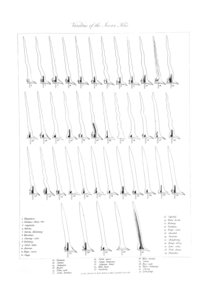 Varieties of Javanese keris.
Varieties of Javanese keris.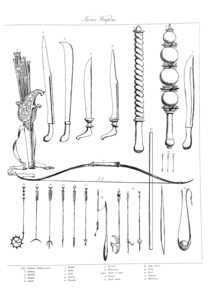 Weapons of Java: Machetes, maces, bow and arrows, blowpipe, sling.
Weapons of Java: Machetes, maces, bow and arrows, blowpipe, sling. Weapon of Java: Keris.
Weapon of Java: Keris. Short swords, shields, and a matchlock gun.
Short swords, shields, and a matchlock gun.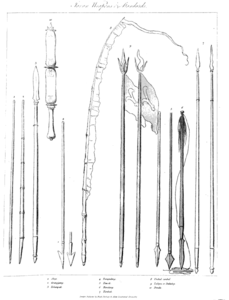 Javanese weapons and standards.
Javanese weapons and standards.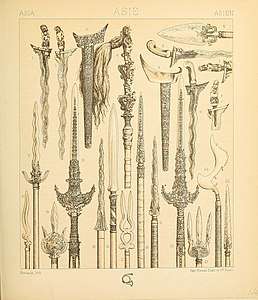 Various keris and pole weapons of Java
Various keris and pole weapons of Java
Blacksmiths are traditionally valued. Some blacksmiths fast and meditate to reach perfection. Javanese blacksmiths create a range of tools and farming equipment, and also cultural items such as gamelan instruments and kris.[65] The Majapahit used fire-arms and cannonade as a feature of warfare. Cetbang, the Javanese bronze breech-loaded swivel-gun, was used ubiquitously by the Majapahit navy, pirates, and rival lords. The demise of the Majapahit empire also caused the flight of disaffected skilled bronze cannon-smiths to Brunei, modern Sumatra and Malaysia, and the Philippines. This led to near universal use of the swivel-gun, especially on trade vessels to protect against pirates, in the Makassar Strait.[79] Pole gun (bedil tombak) was recorded as being used by Javanese people in 1413.[80][81]
Duarte Barbosa ca. 1510 said that the inhabitants of Java are great masters in casting artillery and very good artillerymen. They make many one-pounder cannons (cetbang or rentaka), long muskets, spingarde (arquebus), schioppi (hand cannon), Greek fire, guns (cannons), and other fire-works. Every place are considered excellent in casting artillery, and in the knowledge of using it.[82][83] In 1513, the Javanese fleet led by Patih Yunus, sailed to attack Portuguese Malacca "with much artillery made in Java, for the Javanese are skilled in founding and casting, and in all works in iron, exceeding what they have in India".[84][85]:23
Kris knives are important items, with many heirloom kris holding significant historical value. The design of the kris is to tear apart an opponent's abdomen, making the injury more severe.
Kota Gede is famous for its silverworks and silver handicrafts.[86]
Batik making
Batiks are traditionally made by women as a pastime, but some town and villages have specialised in making batik, such as Pekalongan, Kauman, Kampung Taman and Laweyan.
Wood carving

The Javanese art of wood carving is traditionally applied to various cultural attributes such as statues, (wayang-)dolls, and masks. Woodcarving also prominent as house ornamentation and details. The elaborately carved Omah Kudus is a fine example of Javanese woodcarving mastery. The Central Java town of Jepara is famous as a center of Javanese woodcarving workshops, where artists and carpenters especially working on Javan teak wood.[87]
Migrations
The Javanese were probably involved in the Austronesian migration to Madagascar in the first centuries C.E. While the culture of the migration is most closely related with the Ma'anyan people of Borneo, a portion of the Malagasy language is derived from loanwords from the Javanese language.[88]
Since the Hindu kingdom period, Javanese merchants settled at many places in the Indonesian archipelago.[29]:247 In the late 15th century, following the collapse of Majapahit and the rise of Muslim principalities on the northern coast of Java, many Hindu nobilities, artisans and courtiers migrated to Bali,[30] where they would contribute to the refined culture of Bali. Others who refused to convert to Islam retreated to Tengger mountain, retaining their Hindu religion and becoming the Tenggerese people.
In the conflicts during the transitions of power between the Demak, the Pajang and the Mataram in the late 16th century, some Javanese migrated to Palembang in southern Sumatra. There they established a sultanate and formed a mix of Malay and Javanese culture.[89] Palembang language is a dialect of Malay language with heavy influence of Javanese.
During the reign of Sultan Agung (1613–1645), some Javanese began to establish settlements in coastal West Java around Cirebon, Indramayu and Karawang. These Javanese settlements were originally commissioned by Sultan Agung as rice farming villages to support the Javanese troop logistics on his military campaign against Dutch Batavia.
The Javanese were also present in Peninsular Malaya since early times.[90] The Link between Java and Malacca was important during spread of Islam in Indonesia, when religious missionaries were sent from Malacca to seaports on the northern coast of Java.[32] Large migrations to the Malay Peninsula occurred during the colonial period, mostly from Central Java to British Malaya. Migration also took place from 1880 to 1930 from other parts of Java with a secondary migration Javanese from Sumatra. Those migrations were to seek a new life away from the Dutch colonists who ruled Indonesia at that time. Today these people live throughout Peninsular Malaysia and are mainly concentrated in parts of Johor, Perak and Selangor and cities such as Kuala Lumpur.
Today, the Javanese of Malaysia are included in the Malay race along with other native Indonesian ethnic groups, the so-called bumiputera. Many immigrants of the colonial period retain their Javanese identity, and the Javanese language is still spoken, although the younger generation in urban centers mostly has shifted to Malay.[91]
In Singapore, approximately 50-60% of its Malay population have some degree of Javanese ancestry. Most of them have identified themselves as Malays, rather than Javanese.[92]
Javanese merchants were also present in the Maluku Islands as part of the spice trade. Following the Islamisation of Java, they spread Islam in the islands, with Ternate being a Muslim sultanate circa 1484.[93] Javanese merchants also converted coastal cities in Borneo to Islam.[94] The Javanese thus played an important part in transmitting Islam from the western part to the eastern part of the Archipelago with trade based from northern coast of Java.
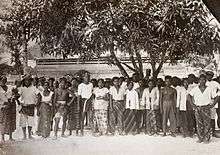
New migration patterns emerged during colonial periods. During the rise of VOC power starting in the 17th century, many Javanese were exiled, enslaved or hired as mercenaries for the Dutch colonies of Ceylon in South Asia and the Cape colony in South Africa. These included princes and nobility who lost their dispute with the Company and were exiled along with their retinues. These, along with exiles from other ethnicities like Bugis and Malay became the Sri Lankan Malay[36] and Cape Malay[37] ethnic groups respectively. Other political prisoners were transported to closer places. Prince Diponegoro and his followers were transported to North Sulawesi, following his defeat in Java War in the early 19th century. Their descendants are well known as Jaton (abbreviation of "Jawa Tondano"/Tondano Javanese).
Major migrations started during the Dutch colonial period under Transmigration programs. The Dutch needed many labourers for their plantations and moved many Javanese under the program as contract workers, mostly to other parts of the colony in Sumatra. They also sent Javanese workers to Suriname in South America.[95] As of 2019, approximately 13.7% of the Suriname population is of Javanese ancestry.[11] Outside of the Dutch colonies, Javanese workers were also sent to plantations administrated by the Dutch colonial government in New Caledonia, a French territory.[95]
The Transmigration program that was created by the Dutch continued following independence. A significant Javanese population can be found in the Jabodetabek (Greater Jakarta) area, Lampung, South Sumatra and Jambi provinces. Several paguyuban (traditional community organisation) were formed by these Javanese immigrants, such as "Pujakesuma" (abbreviation of Indonesian: Putra Jawa Kelahiran Sumateran or Sumatra-born Javanese).
Notable people
See also
References
- Pramono, S.B. (2013). Piwulang Basa Jawa Pepak. Grafindo Litera Media. ISBN 978-979-3896-38-0.
- Kewarganegaraan, Suku Bangsa, Agama dan Bahasa Sehari-hari Penduduk Indonesia - Hasil Sensus Penduduk 2010. Badan Pusat Statistik. 2011. ISBN 978-979-064417-5. Archived from the original on 10 July 2017.
- Palash Ghosh (31 January 2013). "Uneasy Neighbors: The Plight of Illegal Indonesian Immigrants In Malaysia". International Business Times. Retrieved 12 May 2018.
- Kompasiana (2016). Kami Tidak Lupa Indonesia. Bentang Pustaka. ISBN 9786022910046.
- Silvey, Rachel (2005), "Transnational Islam: Indonesian Migrant Domestic Workers in Saudi Arabia", in Falah, Ghazi-Walid; Nagel, Caroline (eds.), Geographies of Muslim Women: Gender, Religion, and Space, Guilford Press, pp. 127–146, ISBN 1-57230-134-1
- "產業及社福外籍勞工人數-按國籍分". 行政院勞動部勞力發展署. Retrieved 10 May 2018.
- "TKI di China Lebih Besar Dibandingkan Pekerja China di RI". Okezone.com (in Indonesian). Retrieved 11 May 2018.
- "Hong Kong". The World Factbook. Central Intelligence Agency. Retrieved 10 May 2018.
- "TKI di Singapura Bisa Kirim Uang ke Kampung Lewat HP". Detik.com (in Indonesian). Retrieved 11 May 2018.
- "1,3 Juta TKI Kerja di Timteng Terbanyak Arab Saudi". Detik.com (in Indonesian). Retrieved 11 May 2018.
- "Suriname". The World Factbook. Central Intelligence Agency. 18 December 2019. Retrieved 23 December 2019.
- Ko Oudhof, Carel Harmsen, Suzanne Loozen en Chan Choenni, "Omvang en spreiding van Surinaamse bevolkingsgroepen in Nederland" (CBS - 2011)
- Ko Oudhof en Carel Harmsen, "De maatschappelijke situatie van Surinaamse bevolkingsgroepen in Nederland" (CBS - 2011)
- "Ini Data TKA di Indonesia dan Perbandingan Dengan TKI di Luar Negeri". Kompas.com (in Indonesian). Retrieved 11 May 2018.
- Project, Joshua. "Javanese in Australia". joshuaproject.net.
- Institut de la statistique et des études économiques de Nouvelle-Calédonie (ISEE). "Population totale, selon la communauté par commune et Province de résidence" (in French). Archived from the original (XLS) on 28 September 2007.
- Project, Joshua. "Javanese in Germany". joshuaproject.net.
- Harjawiyana, Haryana; Theodorus Supriya (2001). Kamus unggah-ungguh basa Jawa. Kanisius. p. 185. ISBN 978-979-672-991-3.
- Ananta, Aris; Arifin, Evi Nurvidya; Hasbullah, M. Sairi; Handayani, Nur Budi; Pramono, Agus (December 2015). Demography of Indonesia’s Ethnicity (in Indonesian). Institute of Southeast Asian Studies. doi:10.1355/9789814519885. ISBN 978-981-4519-87-8. Retrieved 28 December 2019.
- "Publication Name:". Archived from the original on 10 July 2017. Retrieved 6 August 2013.
- Margaret Kleffner Nydell Understanding Arabs: A Guide For Modern Times, Intercultural Press, 2005, ISBN 1931930252, page xxiii, 14
- roughly 152 million Bengali Muslims in Bangladesh and 36.4 million Bengali Muslims in the Republic of India (CIA Factbook 2014 estimates, numbers subject to rapid population growth); about 10 million Bangladeshis in the Middle East, 1 million Bengalis in Pakistan, 5 million British Bangladeshi.
- Gandhi, Rajmohan (2013). Punjab: A History from Aurangzeb to Mountbatten. New Delhi, India, Urbana, Illinois: Aleph Book Company. p. 1. ISBN 978-93-83064-41-0.
- Spiller, Henry (2008). Gamelan music of Indonesia. Taylor & Francis. ISBN 978-0-415-96067-0.
- Taylor (2003), p. 7.
- "Pemetaan Genetika Manusia Indonesia". Kompas.com (in Indonesian). Archived from the original on 23 February 2016. Retrieved 5 September 2017.
- Miksic, John; Marcello Tranchini; Anita Tranchini (1996). Borobudur: Golden Tales of the Buddhas. Tuttle Publishing. ISBN 978-0-945971-90-0.
- Tarling, Nicholas (1999). Cambridge history of South East Asia: From early times to c.1500. Cambridge University Press. p. 203. ISBN 978-0-521-66369-4.
- Spuler, Bertold; F.R.C. Bagley (31 December 1981). The Muslim world: a historical survey, Part 4. Brill Archive. p. 252. ISBN 978-90-04-06196-5.
- Capaldi, Liz; Joshua Eliot (2000). Bali handbook with Lombok and the Eastern Isles: the travel guide. Footprint Travel Guides. ISBN 978-0-658-01454-3.
- Marshall Cavendish Corporation (2007). World and Its Peoples: Indonesia and East Timor. Marshall Cavendish. p. 1333. ISBN 978-0-7614-7643-6.
- Wink, André (2004). Indo-Islamic society, 14th-15th centuries. BRILL. p. 217. ISBN 978-90-0413561-1.
- Ricklefs, M.C. (1991). A History of Modern Indonesia since c.1300, 2nd Edition. London: MacMillan. pp. 9–10. ISBN 0-333-57689-6.
- Muljana, Slamet (2005). Runtuhnya kerajaan Hindu-Jawa dan timbulnya negara-negara Islam di Nusantara. Yogyakarta, Indonesia: LKiS. ISBN 979-8451-16-3.
- Pires, Tomé (1990). The Suma oriental of Tome Pires: an account of the East. New Delhi: Asian Educational Services. ISBN 81-206-0535-7.
- Shucker, M. A. M. (1986). Muslims of Sri Lanka: avenues to antiquity. Jamiah Naleemia Inst. OCLC 15406023.
- Williams, Faldela (1988). Cape Malay Cookbook. Struik. ISBN 978-1-86825-560-3.
- Matusky, Patricia Ann; Sooi Beng Tan (2004). The music of Malaysia: the classical, folk, and syncretic traditions. Ashgate Publishing. pp. 107. ISBN 978-0-7546-0831-8.
- Osnes, Beth (2010). The Shadow Puppet Theatre of Malaysia: A Study of Wayang Kulit with Performance Scripts and Puppet Designs. McFarland. p. 26. ISBN 978-0-7864-4838-8.
- Robson, Stuart; Singgih Wibisono (2002). Javanese English dictionary. Tuttle Publishing. ISBN 978-0-7946-0000-6.
- Marr, David G.; Anthony Crothers Milner (1986). Southeast Asia in the 9th to 14th centuries. Institute of Southeast Asian Studies. ISBN 978-9971-988-39-5.
- Errington, James Joseph (1998). Shifting languages: interaction and identity in Javanese Indonesia. Cambridge University Press. ISBN 978-0-521-63448-9.
- Soeseno, Ki Nardjoko (2014). Falsafah Jawa Soeharto & Jokowi. Araska. ISBN 978-602-7733-82-4.
- McDonald, Hamish (1980). Suharto's Indonesia. Melbourne: Fontana. pp. 9–10. ISBN 0-00-635721-0.
- Ananta, Arifin & Bakhtiar 2008, p. 30.
- Geertz, Clifford (1976). The religion of Java. University of Chicago Press. ISBN 978-0-226-28510-8.
- Beatty, Andrew (1999). Varieties of Javanese religion: an anthropological account. Cambridge University Press. ISBN 978-0-521-62473-2.
- Gin 2004, p. 719.
- Caldarola 1982, p. 501.
- Hooker 1988, p. 196.
- Ministry of Culture and Tourism of the Republic of Indonesia (6 October 2009). "Trowulan - Former Capital City of Majapahit Kingdom". United Nations Educational, Scientific and Cultural Organization (UNESCO) World Heritage Convention.
- Karaton Ngayogyakarta Hadiningrat (2002). Kraton Jogja: the history and cultural heritage. Kraton Yogyakarta, Indonesia Marketing Association. ISBN 978-979-969060-9.
- Eliot, Joshua; Liz Capaldi; Jane Bickersteth (2001). Indonesia handbook, Volume 3. Footprint Travel Guides. p. 303. ISBN 978-1-900949-51-4.
- Kusno, Abidin (2000). Behind the postcolonial: architecture, urban space, and political cultures in Indonesia. Routledge. p. 3. ISBN 9780415236157.
- Singh, Nagendra Kr (2002). International encyclopaedia of Islamic dynasties. Anmol Publications. p. 148. ISBN 978-81-2610403-1.
- Kalekin-Fishman, Devorah; Kelvin E. Y. Low (2010). Everyday Life in Asia: Social Perspectives on the Senses. Ashgate Publishing, Ltd. p. 52. ISBN 978-0-7546-7994-3.
- DuFon, Margaret A.; Eton Churchill (2006). Language learners in study abroad contexts. Multilingual Matters. p. 110. ISBN 978-1-85359-851-7.
- Tania, Vania. Djakabaia: Djalan-djalan dan Makan-makan. Gramedia Pustaka Utama. ISBN 978-979-223923-2.
- Tempat Makan Favorit di 6 Kota. AgroMedia. 2008. p. 136. ISBN 978-979-006166-8.
- Witton, Patrick; Mark Elliott; Paul Greenway; Virginia Jealous (2003). Indonesia. Lonely Planet. p. 108. ISBN 978-1-74059-154-6.
- Soebroto, Chris. Indonesia OK!!: the guide with a gentle twist. Galangpress Group. p. 72. ISBN 978-979-934179-2.
- Kim, Hyung-Jun (2006). Reformist Muslims in Yogyakarta Village: the Islamic transformation of contemporary socio-religious life. ANU E Press. p. 126. ISBN 978-1-920942-34-2.
- Owen, Sri (1999). Indonesian Regional Food and Cookery. Frances Lincoln Ltd. p. 173. ISBN 978-0-7112-1273-2.
- Gérard, Françoise; François Ruf (2001). Agriculture in crisis: people, commodities and natural resources in Indonesia, 1996-2000. Routledge. p. 301. ISBN 978-0-7007-1465-0.
- Dunham, Stanley Ann; Alice G. Dewey (2009). Surviving Against the Odds: Village Industry in Indonesia. Duke University Press. p. 50. ISBN 978-0-8223-4687-6.
- Dick-Read, Robert (2005). The Phantom Voyagers: Evidence of Indonesian Settlement in Africa in Ancient Times. Thurlton.
- Beale, Philip (April 2006). "From Indonesia to Africa: Borobudur Ship Expedition". Ziff Journal: 22 – via http://www.swahiliweb.net/ziff_journal_3_files/ziff2006-04.pdf.
- Blench, “The Ethnographic Evidence for Long-distance Contacts”, p. 432.
- I. W. Ardika & P. Bellwood, “Sembiran: The Beginnings of Indian Contact with Bali”, Antiquity 65 (1991): 221–32. See also I. W. Ardika, P. Bellwood, I. M. Sutaba & K. C. Yuliati, “Sembiran and the First Indian Contacts with Bali: An Update”, Antiquity 71(1997): 193–95.
- Nugroho, Irawan Djoko (2011). Majapahit Peradaban Maritim. Suluh Nuswantara Bakti. ISBN 9786029346008.
- Jones, John Winter (1863). The travels of Ludovico di Varthema in Egypt, Syria, Arabia Deserta and Arabia Felix, in Persia, India, and Ethiopia, A.D. 1503 to 1508. Hakluyt Society.
- Cartas de Afonso de Albuquerque, Volume 1, p. 64, April 1, 1512
- Liebner, Horst H. (2002). Perahu-Perahu Tradisional Nusantara. Jakarta.
- "Majapahit-era Technologies". Nusantara Review. 2 October 2018. Retrieved 11 June 2020.
- de Couto, Diogo (1602). Decada Quarta da Asia. Portugal: Em Lisboa : Impresso por Pedro Crasbeeck.
- Couto, Diogo do (1645). Da Asia: Nine decades. Lisbon: Regia Officina Typografica, 1778-88. Reprint, Lisbon, 1974.
- Pires, Tome (1944). Suma Oriental. London: The Hakluyt Society. ISBN 9784000085052.
- Lombard, Denys (1990). The Javanese Crossroads. Essay of Global History. ISBN 2713209498.
- Thomas Stamford Raffles, The History of Java, Oxford University Press, 1965, ISBN 0-19-580347-7, 1088 pages.
- Mayers (1876). "Chinese explorations of the Indian Ocean during the fifteenth century". The China Review. IV: p. 178.
- Manguin, Pierre-Yves (1976). "L'Artillerie legere nousantarienne: A propos de six canons conserves dans des collections portugaises". Arts Asiatiques. 32: 233–268.
- Barosa, Duarte (1866). A Description of the Coasts of East Africa and Malabar in the Beginning of the Sixteenth Century. The Hakluyt Society.
- Partington, J. R. (1999). A History of Greek Fire and Gunpowder. JHU Press. ISBN 978-0-8018-5954-0.
- Reid, Anthony (2012). Anthony Reid and the Study of the Southeast Asian Past. Institute of Southeast Asian Studies. ISBN 978-981-4311-96-0.
- Crawfurd, John (1856). A Descriptive Dictionary of the Indian Islands and Adjacent Countries. Bradbury and Evans.
- Tadié, J; Guillaud, Dominique (ed.); Seysset, M. (ed.); Walter, Annie (ed.) (1998), Kota Gede : le devenir identitaire d'un quartier périphérique historique de Yogyakarta (Indonésie); Le voyage inachevé... à Joël Bonnemaison, ORSTOM, retrieved 20 April 2012CS1 maint: extra text: authors list (link)
- "In a Central Java town, local wood enterprises carve a niche in the global market - CIFOR Forests News". CIFOR Forests News. 6 March 2018. Retrieved 1 June 2018.
- Adelaar, Alexander (2006). The Indonesian migrations to Madagascar: making sense of the multidisciplinary evidence. Melbourne Institute of Asian Languages and Societies, The University of Melbourne. ISBN 9789792624366.
- Simanjuntak, Truman; Ingrid Harriet Eileen Pojoh; Muhamad Hisyam (2006). Austronesian diaspora and the ethnogeneses of people in Indonesian archipelago. Yayasan Obor Indonesia. p. 422. ISBN 978-979-26-2436-6.
- Crawfurd, John (1856). A descriptive dictionary of the Indian islands & adjacent countries. Bradbury & Evans. pp. 244.
- Miyazaki, Koji (2000). "Javanese-Malay: Between Adaptation and Alienation". Sojourn: Journal of Social Issues in Southeast Asia. 15 (1): 76–99. JSTOR 41057030. P. 83: "Generally speaking, however, as one might expect, younger Javanese-Malays can hardly understand Javanese and are Malay monolingual".
- LePoer, Barbara Leitch (1991). Singapore, a country study. Federal Research Division, Library of Congress. p. 83. Retrieved 17 February 2013.
Singapore Malay community leaders estimated that some 50 to 60 percent of the community traced their origins to Java and an additional 15 to 20 percent to Bawean Island, in the Java Sea north of the city of Surabaya.
- Storch, Tanya (2006). Religions and missionaries around the Pacific, 1500-1900. Ashgate Publishing. ISBN 978-0-7546-0667-3.
- Lapidus, Ira Marvin (2002). A history of Islamic societies. Cambridge University Press. p. 384. ISBN 978-0-521-77933-3.
- Martinez, J.T; Vickers, A.H (2012). "Indonesians overseas - deep histories and the view from below". Indonesia and the Malay World. 40 (117): 111–121. doi:10.1080/13639811.2012.683667. Retrieved 28 December 2019.
Sources
- Caldarola, Carlo (1982), Religion and Societies: Asia and the Middle East, Walter de Gruyter
- Gin, Ooi Keat (2004), Southeast Asia: A Historical Encyclopedia, from Angkor Wat to Timor. R-Z. Volume three, ABC-CLIO
- Hooker, M.B. (1988), Islam in South East Asia, Brill
Further reading
- Kuncaraningrat Raden Mas; Southeast Asian Studies Program (Institute of Southeast Asian Studies) (1985), Javanese culture, Oxford University Press, ISBN 978-0-19-582542-8
| Wikimedia Commons has media related to Javanese people. |
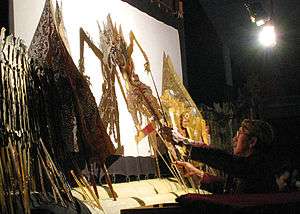

.png)
